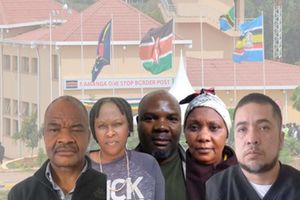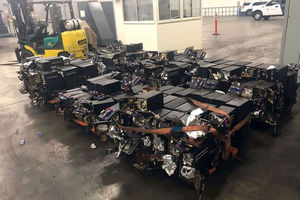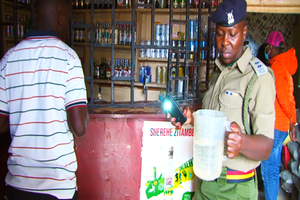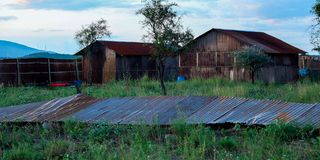
The methamphetamine laboratory in Olelopo village, Namanga, Kajiado County in this photo taken on March 19, 2025.
The makeshift structure that was supposed to be a laboratory for one of the most feared Mexican drug cartels in Olelopo village, Namanga town, Kajiado County still stands like an abandoned factory.
There is no activity on the site, which is still heavily guarded by a contingent of security officers working in shifts since the clandestine operation was busted last September.
The two makeshift iron structures on the 10-acre site are corroded, perhaps from the chemicals inside that were to be used to produce one of the world's most dangerous drugs, methamphetamine. It's a highly addictive, lab-made (synthetic) stimulant.
The lab is located in a sparsely populated village, a remote area about eight kilometres off the Nairobi-Namanga highway, away from prying eyes – the perfect choice of location for an illegal operation.
Access to the area is also quite difficult for visitors. The only way to get there is by off-road vehicle or boda-boda.
Local people are still fearful of the cartel, perhaps because they now know what goes on behind the fences of this secretive facility. No one is willing to talk openly about the matter, and those who do demand anonymity.
The cartels convinced the residents that they were setting up a chicken farm because of the increasing demand for eggs and chicken meat in the market. It was a plausible explanation that would not raise eyebrows.
They divided the land into three parts. From the outside, the land is surrounded by a barbed wire fence. There is a small structure at the entrance from where security guards keep an eye on things.
Inside, a second fence is erected, followed by a third barrier of iron sheeting, which surrounds almost the two acres on which the laboratory structure is located.
According to one of the locals, they were told that a chicken coop was being built inside.
“We rarely saw those people coming here. They said that they were in a business of rearing chicken but no one ever saw the birds,” said a person who spoke on condition of anonymity.
Residents said the occupants were rarely seen driving cars when they visited. Instead, they used motorcycles. They only used vehicles when transporting goods.
Residents became suspicious of the activities and their concerns grew when they saw items such as gas cylinders and water tanks being offloaded. They reported the matter to the area chief, who contacted the Oloililai Sub-County Police Commander, Hassan Elema.

Oloililai Sub-county Police Commander Hassan Elema on March 19, 2025.
In an exclusive interview with Nation.Africa, Mr Elema said the illegal business was discovered in September last year and preliminary investigations indicate that the land was bought by a Kenyan woman around July 2024.
Mr Elema said the cartel operated in a clandestine manner, using a Kenyan to buy land from a local, which did not raise suspicion as most people in the area sell land to visitors.
“This gentleman sold the land and I cannot say the total amount of money that they agreed and paid, but what I know is that the seller has not received part of the cash. He received about 80 percent of the total amount,” Mr Elema discloses.
He claims that the illegal laboratory was busted before production started.
“Looking at that duration between July and September for them to make the agreement, buy the land and setup the factories, they did not succeed to operationalise the clandestine lab,” Mr Elema said.
He said the Directorate of Criminal Investigations (DCI) was alerted in September. Security agents, who included anti-narcotics unit officers, raided the facility on September 12, 2024. Detectives concluded that the suspects had done some test-runs, but had not started full-scale production.
Police said those arrested in the raid were Kenyans Betty Mukami Micheni, Caroline Wambu Muchira and Francis Maina Gachau, Nigerian brothers Agwu Ojukwu and Egwu Ogba, and Mexican Alvarado Israel Vera.
The DCI said the first suspect, Ms Micheni, was arrested at her home in Ruiru on September 16. She is suspected to have masterminded the establishment of the facility along with Mr Ojukwu.
Among the items recovered from Ms Micheni's house were several documents linking her to the purchase, chemicals and equipment seized.
Police accuse Ms Micheni of importing several chemicals, including sodium hydroxide flakes, tartaric acid, methylamine and mercuric chloride from Mumbai-based Aadish Impex Privet Company.
These four chemicals are the main ingredients used in the production of methamphetamine.
Once inside Kenya's borders, the chemicals would be transported to the clandestine drug laboratory, better known as a clan lab.
Here, authorities say, Vera was to help cook the meth with two Mexican colleagues. Between April and September 2024, police say Vera, Carlos Pedro and Ignacio Morales Alvarez set up equipment, received chemicals and attempted to produce methamphetamine. Mr Vera was arrested on October 5, 2024 at Jomo Kenyatta International Airport (JKIA) as he attempted to board a flight back to Mexico.
Mr Pedro and Mr Alvarez are on the run, but are on watch lists in several countries around the world, including the US.
It is believed that the two Mexicans were brought into the country by Mr Ojukwu.
Mr Ojukwu was arrested at JKIA on October 3, 2024 as he attempted to board a flight back to Nigeria. Police say he was found in possession of plans for the meth lab, the mother title deed from which the 10 acres of land was carved out, and other documents that are now considered evidence.
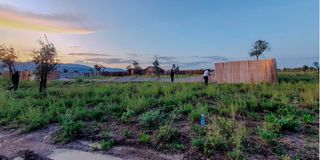
Makeshift perimeter wall for a methamphetamine laboratory in Olelopo village, Namanga, Kajiado County on March 19, 2025.
Residents have been praised for tipping off security officials about the lab, stopping one of the most dangerous substances from circulating in the country.
“Police officers cannot be everywhere but through the collaboration between us and the community and other government agencies, we are fully alert,” Mr Elema added.
While the community remains on high alert because some of the suspects linked to the lab are still at large, the police have assured whistleblowers of protection.
“We are not going to share their names but we are going to act (on the information they give),” Mr Elema said.
The illegal structure is still on the land after a push and pull between the owners and the Office of the Director of Public Prosecutions (ODPP).
A court order to demolish the illegal premises has yet to be enforced five months after the drug den was discovered because the suspects, who own the land, have challenged the finding that illegal drugs were found there. The suspects want the laboratory tests to be repeated.

